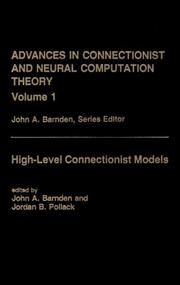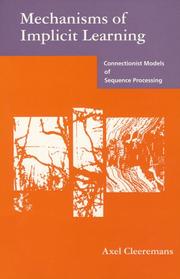| Listing 1 - 4 of 4 |
Sort by
|
Periodical
Abstract | Keywords | Export | Availability | Bookmark
 Loading...
Loading...Choose an application
- Reference Manager
- EndNote
- RefWorks (Direct export to RefWorks)
Neural networks (Computer science) --- Connection machines. --- Artificial intelligence. --- Artificial intelligence --- Connection machines --- Neural Networks, Computer --- Artificial Intelligence --- Réseaux neuronaux (Informatique) --- Intelligence artificielle --- Connection Machine --- Connection Machine. --- Intelligence artificielle. --- Periodicals. --- Périodiques.

ISBN: 0893916870 9780893916879 Year: 1991 Volume: v. 1 Publisher: Norwood, N.J. Ablex
Abstract | Keywords | Export | Availability | Bookmark
 Loading...
Loading...Choose an application
- Reference Manager
- EndNote
- RefWorks (Direct export to RefWorks)
Book
ISBN: 0262132702 Year: 1991 Publisher: Cambridge (MA) ; London : M.I.T. Press,
Abstract | Keywords | Export | Availability | Bookmark
 Loading...
Loading...Choose an application
- Reference Manager
- EndNote
- RefWorks (Direct export to RefWorks)

ISBN: 0262032058 0262270471 0585020388 9780262032056 9780262270472 9780585020389 Year: 1993 Volume: vol *1 Publisher: Cambridge, Mass. MIT
Abstract | Keywords | Export | Availability | Bookmark
 Loading...
Loading...Choose an application
- Reference Manager
- EndNote
- RefWorks (Direct export to RefWorks)
"What do people learn when they do not know that they are learning? Until recently all of the work in the area of implicit learning focused on empirical questions and methods. In this book, Axel Cleeremans explores unintentional learning from an information-processing perspective. He introduces a theoretical framework that unifies existing data and models on implicit learning, along with a detailed computational model of human performance in sequence-learning situations. The model, based on a simple recurrent network (SRN), is able to predict perfectly the successive elements of sequences generated from finite-state, grammars. Human subjects are shown to exhibit a similar sensitivity to the temporal structure in a series of choice reaction time experiments of increasing complexity; yet their explicit knowledge of the sequence remains limited. Simulation experiments indicate that the SRN model is able to account for these data in great detail. Cleeremans' model is also useful in understanding the effects of a wide range of variables on sequence-learning performance such as attention, the availability of explicit information, or the complexity of the material. Other architectures that process sequential material are considered. These are contrasted with the SRN model, which they sometimes outperform. Considered together, the models show how complex knowledge may emerge through the operation of elementary mechanisms - a key aspect of implicit learning performance."
Artificial intelligence. Robotics. Simulation. Graphics --- Computer architecture. Operating systems --- Connection machines --- Implicit learning --- Neural networks (Computer science) --- Neurale netwerken (Informatica) --- Réseaux neuraux (Informatique) --- Implicit learning. --- Connectionism. --- Connection machine --- Réseaux neuronaux (Informatique) --- Apprentissage implicite --- Connexionnisme --- Artificial neural networks --- Nets, Neural (Computer science) --- Networks, Neural (Computer science) --- Neural nets (Computer science) --- Artificial intelligence --- Natural computation --- Soft computing --- Learning, Psychology of --- Parallel computers --- Réseaux neuronaux (Informatique) --- Connection machines. --- COGNITIVE SCIENCES/General --- COGNITIVE SCIENCES/Psychology/Cognitive Psychology
| Listing 1 - 4 of 4 |
Sort by
|

 Search
Search Feedback
Feedback About UniCat
About UniCat  Help
Help News
News